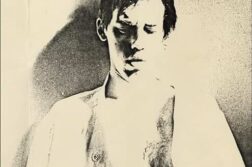 Hymn To Apollo: The Ancient World & the Ballets Russes
Hymn To Apollo: The Ancient World & the Ballets Russes
Institute for the Study of the Ancient World, NYU
March 6–June 2, 2019
THERE IS much truth to the adage “everything old is new again,” as demonstrated by the exquisite exhibit Hymn To Apollo: The Ancient World and the Ballets Russes at NYU’s Institute for the Study of the Ancient World. This show explores how archaic and classical arts inspired the innovative and often radical creations of the Ballets Russes from the time of its founding by impresario Sergei Diaghilev in 1909. The show displays over 95 objects, including ancient pottery, sculpture, metalwork, jewelry, friezes, costumes, photos, digitalized films of Ballets Russes performances, musical scores, paintings, set designs, and historic archival materials.
As we walk through the exhibit, we’re introduced to magnificent ancient artifacts as well as archival materials from the Ballets Russes, including many of its key productions: Cléopâtre (1909) L’Après-midi d’un faune (1912), Daphnis et Chloé (1912), and many more. The exhibit attempts to provide an account of what led Diaghilev and the Ballets Russes to turn to antiquity as a source of material for the troupe’s creative productions. Diaghilev was not only a master showman and a creative genius; he also knew how to capitalize on cultural trends. Fin-de-siècle Europe was a world undergoing massive economic, cultural, and political change. Many feared these changes and others anticipated and welcomed the idea of a new world.
As this was happening, the archæologist Heinrich Schliemann shook the world with his discoveries of the ruins of Troy (announced in 1868) and Mycenae (1878). Shortly thereafter, Arthur Evans discovered the ruins of the Minoan civilization and the palace of Knossos on Crete (around 1900). Their findings electrified European culture influencing the arts, design and clothing as well as the work of Sigmund Freud and Carl Jung. The ancient artifacts offered new sources of inspiration and helped to usher in such movements as Art Nouveau and Art Deco.

Excitement over these archæological discoveries found its way into the world of dance. Isadora Duncan (1877–1927) took her inspiration from the archaic and classical Greek arts and developed a philosophy and technique for dance that was based on freedom of movement, with running, jumping, skipping, etc. included in the choreography. The tunic and bare feet or sandals replaced the corseted costumes and pointed slippers of ballet.
Her influence was worldwide and did not go unnoticed by Diaghilev and his Ballets Russes. Duncan danced in Russia in 1904, 1905, and 1909, and several Ballets Russes collaborators saw her performances. Leon Bakst (1866–1924), costume and set designer, was attracted to her physical freedom and her classically influenced tunics and diaphanous costumes. Vaslav Nijinsky (1890–1950) had also watched Duncan when she performed in St. Petersburg and like Bakst he was greatly impressed by her loose garments and freedom of movement.
The exhibit also documents other influences on Diaghilev and the Ballets Russes in their quest to incorporate the arts of antiquity into new forms of dance. In 1872, Friedrich Nietzsche published The Birth of Tragedy, where he discussed the tension between the Apollonian and the Dionysian—the forces of restraint and the forces of passion—and argued that tragedy emerged out of the resolution of this dynamic interaction. The Ballets Russes productions were greatly influenced by both this dichotomy of æsthetic sensibilities and by Wagner’s notion of “gesamtkuntswerk”—a total work of art, the synthesis of poetry, the visual arts, music, and drama. Diaghilev incorporated all of these ideas into his productions.
Needless to say, a vast number of the innovators who helped to bridge the classical world and the modern world were either gay, lesbian, or bisexual, starting with Diaghilev, Nijinsky, Isadora Duncan, and Ida Rubenstein. Isadora Duncan freed the ballerina from the tutu, and Nijinsky in his brilliant role as the Faun placed the male danseur center stage in a sexualized body filled with desire. Antiquity offered them new sources for understanding gender, sexuality, time, and space—the body as embodied subjectively—as a new source of somatic expression.
Irene Javors is a frequent contributor toThe G&LR.






